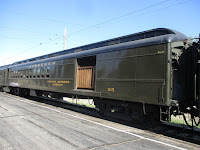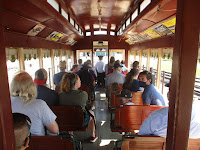Saturday of Showcase Weekend this year was a huge success with lots of Museum members, lots of visitors, and many pieces of equipment in operation. I was too busy to take many good pictures, but I'm sure lots of others will be showing up on the net. And we were there from sunup to sundown.
One of the stars of the show was the Electroliner, of course. It was brought out early in the morning when the sun was in an inconvenient location, but it's stunning from any angle.
And I went for an-after dark ride on the Zephyr, which was quite enjoyable. And then a ride on the Matchbox, with Jack and Frank running the car. And the Museum was still going strong when I left.
Frank adds...
It was indeed a memorably enjoyable Showcase Weekend Saturday. I arrived in the morning, same as my father, and snapped photos of several of the same scenes he did.
I didn't get a chance to go inside the Pawnee or Dover Strait, but the heavyweight train as a complete set made for one heck of an impressive sight. Here the dynamometer and engine are out of sight behind the wood CRT 'L' cars.
Charlie King, who has been first on the IRM member seniority list for a few years now, was visiting. Charlie was responsible for saving CSL 84, the oldest complete trolley bus in America as far as I know, so Richard took the "crackerbox" out for a trip with Charlie along. It was good to see the thing in operation. Here it's passing the 'Liner on display on the 50th Avenue west track.
We had an out-of-town visitor who was stopping by to trade controllers. We ended up with this K-63G, which is the correct type for our Knoxville curve-sider. The Knoxville car isn't on the short list for restoration (and would need a whole lot more than just controllers to be made operable) but this is a pretty distinctive type so it's good to have for future use or future display inside the car.
We also acquired some two-pane, arch-top windows of uncertain origin. A couple have this nifty decal on them. After some sleuthing, I believe they're end bulkhead windows from long-scrapped Rochester Syracuse & Eastern interurban cars. They arrived from central New York; two of the windows have "410" and "437" stamped into their edge, which were both Kuhlman order numbers for cars delivered to the RS&E (a third window has "111" stamped into it, which was the fleet number of an RS&E car built by Niles); and this sticker appears to match a faint outline visible in a photo of RS&E car 118 printed on p92 of CERA B-143, "TravElectric."
During the afternoon I traded off with my father and Jack on VC 19, but after dinner I was Jack's conductor on the "Matchbox." However it appears some wag has put a white stripe on the car's dash, signifying that it's a one-man car! Never fear, the stripe was magnetic vinyl and came right off at the end of the night, but it did give the car a somewhat different appearance. The CSL converted "Matchboxes" 1398 through 1423 to one-man service in 1924 for use on particularly lightly-used lines. Some acquired air doors but most just used the single-stream exit door for both entry and egress while their left-side doors were closed off and the steps removed. One-man "Matchboxes" were used on the Laramie line and can sometimes be seen in the background of photos of CA&E cars at Laramie (and vice versa, as in this photo of a CSL car from the Trolley Dodger site).
Here we are sitting on the near side of Depot Street after sunset. One highlight of the evening was when the steam train did an eastbound run by the depot at speed to do a mail catch. As the only car on the streetcar line, we just pulled up to Car Line Junction and stopped there for a minute, giving our passengers a front-row seat to the truly impressive light and sound show as the 1630 roared past. After the steam train went by, the passengers erupted in spontaneous applause. Kudos to the Steam Team!



































Thank you for all the great photos.
ReplyDeleteRandy, I enjoyed shaking hands with you on Saturday while you were running the open car. It was a beautiful day for sure, nice weather for the open car and seeing the Electroliner actually running. :)
ReplyDeleteWhat makes the K67G controller special or unusual?
C Kronenwetter
Mistyped, I meant the k63G controller.
ReplyDeleteC Kronenwetter
It was neat to see and hear the applause from the 1374 while they did the run with 1630. Not to mention turning the lights off on the car.
ReplyDeleteThere's nothing revolutionary about the K-63G but it's not a very common type. It's roughly as tall as a K-35 but skinnier, kind of like a tall K-75. So using something more common like a K-28 or K-35 in the Knoxville car just wouldn't look right.
ReplyDeleteThis comment has been removed by the author.
ReplyDeleteI know this seems a little off-topic, but do you know the whereabouts or status of Aurora Birney 87? I know it was last seen on a farm on Wagner Road, but other than that, nothing. I do know what happened to sister car 85, but I want to know more about 87.
ReplyDeleteWe looked for it many years ago and could find nothing, so I'm sure it was unceremoniously scrapped by the owner. We have a picture of it from 1966:
ReplyDeletehttps://hickscarworks.blogspot.com/2016/09/diners-and-more-part-6.html
but that's all.
Thanks for the info on Aurora Birney 87. Apparently a door motor was removed from a Birney car body in Aurora to be used on the Illinois Terminal Birney at IRM. I think the door motor was taken off of 85 or 87, or possibly another Birney somewhere in Aurora. Do you know anything about this? Also, are there any other Aurora Birney cars besides 85 and 87 lying around anywhere?
ReplyDelete